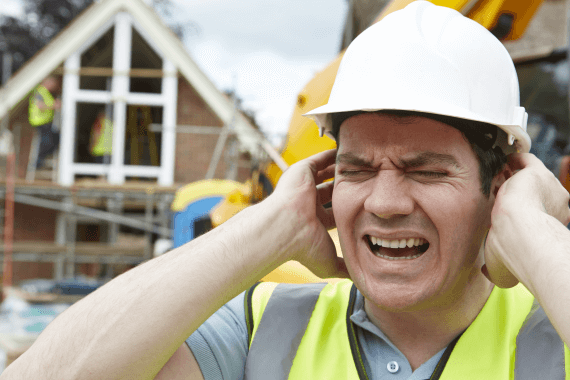- Home ››
- Health and Safety Training ››
- Noise Safety ››
- Noise Risks and Management’s Attitude to Health and Safety
Noise Risks and Management’s Attitude to Health and Safety
Introduction
In the same way that measures should be taken to eliminate a danger before contemplating the use of personal protective equipment (PPE), the same approach should be taken regarding noise risks, which are of course also a danger to people's health and safety. Loud and/or prolonged exposure to noise can cause permanent hearing damage and conditions such as tinnitus.
Dismissing the Danger from Noise
Noise risks can sometimes be overlooked or dismissed simply as an issue which is an inevitable by-product of operations and something which needs to be put up with in order to complete the task. This attitude can either come from the worker themselves or even from management who place more importance on getting the work done by a particular deadline over and above the health and safety of their employees.
Workers

Employees who disregard the dangers which noise in the workplace present will do so either under the instruction and influence of management (discussed in more detail below), or by their own volition. They may do this either because they do not understand the potential risk and damage which can be done to their hearing on a temporary or permanent basis, or due to that common reason for not wearing suitable protective equipment and/or bypassing safety measures: showing off in front of colleagues and friends.
For either of the reasons above, training and a change in attitude will be required in order for employees to work more safely and reduce the likelihood of them suffering damage to either their hearing or indeed another form of accident (it is likely that they will have the same attitude to other health and safety dangers, not just for noise risks). This change in attitude can be brought about through effective health and safety training courses which teach attendees information about the potential risks and the negative effects they can have upon the body. It can also be produced through management implementing and encouraging a health and safety culture within the organisation which, when combined with health and safety training, can create a much safer place of work. Of course, this will be unlikely to happen if management fall into the category discussed below.
Management
Despite safeguarding the health, safety and wellbeing of their employees being a legal requirement, some managers will actively encourage their workers to get the job done as quickly as possible, even if that means bypassing and ignoring any health and safety controls or safety systems which have been put into place to protect them and keep them safe from harm. This attitude to safety, or lack of it, will put workers at risk of suffering damage such as injuries or ill-health.
Management not only have a legal duty to prevent harm coming to workers and members of the public affected by the activities of the organisation, but also a moral responsibility. It will also be in their financial interests too, as it will significantly reduce the likelihood of fines being levied, compensation claims and/or lack of production whilst staff members are off sick but continue to receive full pay. It is therefore in everybody's interests to encourage a positive health and safety culture within the business at all times.
The Subjective Nature of Noise Assessments
The danger to health and safety along with the nuisance level which it poses to nearby residents, not to mention the disturbance to local wildlife and the environment, can be both easily measurable and also extremely subjective too. Consequently, performing noise assessments and evaluating the results can be difficult and subject to opinions and interpretations. This can either lead to slow implementation of necessary changes, or the blocking of their introduction entirely.
Easily Measurable Results
One element of noise assessments which are easy and accurate to measure are the sound levels produced by the activity. Measurements with equipment can give an exact reading as to the decibel levels of sound produced, which is not subjective and can be used as an accurate basis upon which to take suitable actions to prevent excessive noise and protect the health, safety and wellbeing of people and creatures in the nearby vicinity.
Subjective Noise Assessments
Although sound levels can be measured accurately and the figures beyond dispute, there are many aspects of noise assessments which are subjective which can hinder the implementation of effective noise controls and measures which reduce potential harm and/or disturbance to local residents and the environment.
For starters, just how much noise (loudness, length of time, time of day etc) is considered to be a nuisance? Some residents will say any, some will say it is only a problem late in the day or at night, others will not be bothered by it at all having gotten used to it or knowing about it before they moved in. Trying to please everyone is an impossible task, or at least it could only be done by the source closing down and/or relocating, and even then that might cause anger if some of the local people are employed on the site. Some people may not be bothered about the effects of noise on themselves, but may be dissatisfied with the way it scares their pets, especially dogs which can be uncomfortable with strange loud noises.
What To Do
It will not be possible to satisfy everybody, so companies, organisations and individuals causing noise should attempt to reduce noise levels to as low a level as is reasonably practical. This is so that they minimise their impact and disturb as few people as possible. They should comply with all applicable noise legislation in force within their particular jurisdiction, which will sometimes be enough to pacify the local community, but often additional noise reduction actions will need to be put in place.
Businesses and individuals alike need to understand that whilst there is a difference between producing sound levels that pose a danger to health and safety and those which only cause a disturbance, both issues need to be addressed and suitable control measures put in place to prevent such occurrences.
Related Noise Pages:
- Aircraft Noise
- Construction Site Noise & Health and Safety Training
- Farm Noise Nuisance & Health and Safety Issues
- Health and Safety, Noise and Prevention
- How Fitting a Larger Fan May Cause Noise Health and Safety Issues
- Noisy Printers to Quiet Ones - A Benefit for Noise Health and Safety
- Roads - Noise, Environmental & Health and Safety Issues


